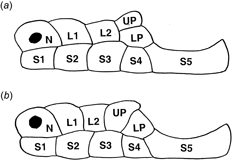Skinks currently assigned to Carlia aerata (Scincidae : Lygosominae) of north-eastern Queensland: a preliminary study of cryptic diversity and two new species
Patrick J. Couper A D , Jessica Worthington Wilmer A , Lewis Roberts B , Andrew P. Amey A and George R. Zug CA Queensland Museum, PO Box 3300, South Bank, Brisbane, Qld 4101, Australia.
B Shipton’s Flat, via PO Cooktown, Qld 4871, Australia.
C Smithsonian Institute, PO Box 37012, Washington, DC 20013-7012, USA.
D Corresponding author. Email: patrickc@qm.qld.gov.au
Australian Journal of Zoology 53(1) 35-49 https://doi.org/10.1071/ZO04010
Submitted: 4 February 2004 Accepted: 18 October 2004 Published: 24 February 2005
Abstract
A preliminary investigation of genetic diversity in Carlia aerata, by sequencing the mitochondrial ND4 gene, revealed the presence of two cryptic species, described herein. The sequence data was added to an existing phylogeny to discern molecular relationships. Interestingly, genetic affinities lie not with C. aerata, the species to which they key. Instead, one has affinities with C. tanneri, the other with C. foliorum. This casts doubt on the validity of morphological characters alone to infer relationships within this genus. Despite low levels of genetic divergence from sister taxa, the new species can be diagnosed from these by morphological characters that exhibit little or no intraspecific variation. The addition of these new species to the gene tree did not enhance resolution of the phylogenetic relationships at the deeper nodes of the Carlia tree. The discovery of these two new cryptic species provides further support for a previously suggested rapid mid-Miocene diversification of Carlia that may have resulted from the successful expansion of a rainforest-dwelling ancestor into the expanding woodlands associated with Miocene climate fluctuations.
Acknowledgments
We thank the Queensland Museum and Smithsonian Institution for providing funds to support this study; Jeanette Covacevich and Pat Zug for assistance in the field; Jeanette Covacevich, Conrad Hoskin and Ross Sadlier for their comments on the manuscript; Allen Greer and Glenn Shea for advice on the significance of character states; Colin Dollery (Queensland Parks and Wildlife Service) for providing a specimen and photographs and habitat data; Nigel Weston (James Cook University), Joe Sambono (JCU) and Alastair Freeman (QPWS) for additional habitat details; Dr James Hanken and José Rosado (Museum of Comparative Zoology, Harvard) for providing digital images of the head scalation of MCZR6476; Dr Devi Stuart-Fox for ongoing discussions and Ms Lauren D. Keim for her assistance in the laboratory.
Blomberg, S. P. , Owens, I. P. F. , and Stuart-Fox, D. M. (2001). Ultraviolet reflectance in the small skink Carlia pectoralis. Herpetological Review 32, 16–17.
Couper, P. J. (1993). A new species of Lygisaurus de Vis (Reptilia: Scincidae) from mideastern Queensland. Memoirs of the Queensland Museum 33, 163–166.
Daugherty, C. H. , Cree, A. , Hay, J. M. , and Thompson, M. (1990). Neglected taxonomy and continuing extinctions of tuatara (Sphenodon). Nature 347, 177–179.
| Crossref | GoogleScholarGoogle Scholar |
Donnellan, S. C. , Hutchinson, M. N. , Dempsey, P. , and Osborne, W. S. (2002). Systematics of the Egernia whitii species group (Lacertilia: Scincidae) in south-eastern Australia. Australian Journal of Zoology 50, 439–459.
| Crossref | GoogleScholarGoogle Scholar |
Garman, S. (1901). Some reptiles and batrachians from Australasia. Bulletin of the Museum of Comparative Zoology 39, 1–14.
Greer, A. E. (1991). Two new species of Menetia from northeastern Queensland with comments on the generic diagnoses of Lygisaurus and Menetia. Journal of Herpetology 25, 268–272.
Huelsenbeck, J. P. , and Ronquist, F. (2001). MRBAYES: Bayesian inference on phylogenetic trees. Bioinformatics (Oxford, England) 17, 754–755.
| PubMed |
Posada, D. , and Crandall, K. A. (1998). Modeltest: testing the model of DNA substitution. Bioinformatics (Oxford, England) 14, 817–818.
| PubMed |
Schneider, C. J. , Cunningham, M. , and Moritz, C. (1998). Comparative phylogeography and the history of endemic vertebrates in the Wet Tropics rainforests of Australia. Molecular Ecology 7, 487–498.
| Crossref | GoogleScholarGoogle Scholar |
Zug, G. R. (2004). Systematics of the Carlia ‘fusca’ lizards (Squamata: Scincidae) of New Guinea and nearby islands. Bishop Museum Bulletin in Zoology 5, 1–82.
illustrates the reconfigured state. It is less confusing to consider the scales by name (i.e. preocular and presubocular) and then score presence or absence. In C. foliorum, the normal condition is two preoculars, no presuboculars, with only 8% of the sample possessing a presubocular scale. A presubocular is always present in C. abscondita but the preoculars are often fused. We define preoculars as the scales that are situated immediately anterior to the orbit. These are upper and lower (but may be fused) and are in broad medial contact. The presubocular contacts the posteroventral margin of the lower preocular. Our lower preocular and presubocular scales were regarded as two presuboculars by Ingram and Covacevich (1988).

|
Appendix 2. Additional material examined
All material is from Queensland unless otherwise stated.
Carlia cf. aerata (Mount Mulligan population)
QMJ45385–87, QMJ45404–07, QMJ64429, Mount Mulligan; QMJ45359, Mt Mulligan summit, 2.5 km SW Mt Mulligan township.
Carlia foliorum
QMJ11891, Tinaroo Dam, 8 km N; QMJ75430–31, Kennedy Hwy, W Ravenshoe; QMJ59749, 40 Mile Scrub NP; QMJ31054, 40 Mile Scrub; QMJ74275, Princess Hills NP; QMJ42461–63, Peak Ra; QMJ70401–02, Conjuboy Holdings; QMJ57284, Eight Mile Ck; QMJ26614, Ingham, 19.9 km S; QMJ58072, QMJ58134, QMJ58136, Hidden Valley, 22 km W Paluma; QMJ58690, Forty Mile Scrub NP; QMJ26625, Moongobulla, 1 km W; QMJ27691–92, QMJ32567–8, Hencamp Ck., 5 km N; QMJ26338, Magnetic I.; QMJ76644–45, Arcadia, Magnetic I.; QMJ77454, Blackbraes NP; QMJ62701, Mt Aberdeen. South Australian Museum R33733, Denham Tip, NSW.
Carlia macfarlani
Northern Territory Museum R23021, R23031, R23034, Maxwell Ck., Melville I., NT; QMJ78355, Coen; QMJ78392, Coen, 2 km S.
Carlia sesbrauna
QMJ78356, QMJ78387–91, USNM Field Herp 036306–7 Klondyke Mine, Station Ck, McIlwraith Ra.
Carlia tanneri
Holotype. QMJ32352, Morgan R Crossing.
Paratypes. QMJ32358–59, Hopevale Mission, 33 km N; QMJ20609–11, QMJ32362–64, McIvor R Crossing; QMJ22380, Tanner Farm; QMJ42771–2, Endeavour R.; QMJ27093–96, Cooktown, 13 km W; QMJ24117–18, Endeavour R., 15 km W Cooktown; QMJ22789, Cedar Scrub, via Cooktown.


